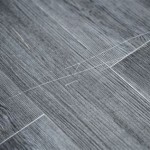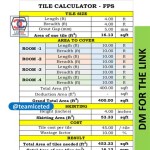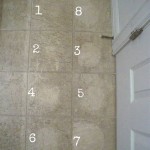Ceramic Tile Flooring Designs for Kitchens
Ceramic tile flooring remains a popular choice for kitchens due to its durability, water resistance, and vast array of design options. Understanding the various types, styles, and installation considerations is crucial for selecting the ideal ceramic tile flooring for a kitchen space. This article explores the diverse world of ceramic tile flooring designs suitable for kitchens, delving into key aspects that influence both aesthetics and functionality.
Types of Ceramic Tiles
Ceramic tiles are broadly classified into several types, each possessing unique characteristics that affect their suitability for kitchen use. These distinctions primarily revolve around manufacturing processes, porosity, and durability ratings.
Earthenware Tiles: These are typically the least expensive and most porous type of ceramic tile. They are fired at lower temperatures, resulting in a softer body that is more susceptible to chipping and staining. Earthenware tiles are generally not recommended for kitchen flooring due to their vulnerability to moisture and heavy foot traffic. They are better suited for wall applications, especially in areas with minimal exposure to water and impact.
Stoneware Tiles: Stoneware tiles offer a mid-range option, providing a balance between cost, durability, and aesthetics. They are denser and less porous than earthenware, making them more resistant to water absorption and staining. Stoneware is a suitable choice for kitchens with moderate foot traffic and regular cleaning. Many stoneware tiles are available in a wide variety of colors, patterns, and textures, allowing for diverse design possibilities.
Porcelain Tiles: Porcelain tiles are the densest and most durable type of ceramic tile. They are fired at extremely high temperatures, resulting in a non-porous surface that is highly resistant to water, stains, scratches, and wear. Porcelain tiles are an excellent choice for kitchen flooring due to their exceptional performance and longevity. They can withstand heavy foot traffic, spills, and frequent cleaning without showing signs of damage. Porcelain tiles are also available in a wide range of styles, including those that mimic natural stone, wood, and concrete.
Quarry Tiles: Quarry tiles are a type of unglazed ceramic tile made from natural clay. They are known for their rustic appearance, durability, and slip resistance. Quarry tiles are often used in commercial kitchens and high-traffic areas, but they can also be an attractive and functional choice for residential kitchens. Their natural color variations and textured surface provide a unique aesthetic that complements a variety of design styles.
Understanding the properties of each tile type is essential for making an informed decision about the best option for a specific kitchen environment. Factors to consider include budget, expected foot traffic, potential for spills and stains, and desired aesthetic.
Design Considerations for Kitchen Tile Flooring
The design of kitchen tile flooring extends beyond simply selecting a color and pattern. It involves careful consideration of size, shape, layout, and texture to create a cohesive and visually appealing space. The following design considerations are vital for achieving a successful outcome.
Tile Size and Shape: The size and shape of tiles can significantly impact the overall look and feel of a kitchen. Larger tiles can create a more spacious and modern aesthetic, while smaller tiles can add visual interest and texture. Rectangular tiles, such as subway tiles, can be arranged in various patterns, such as brick bond or herringbone, to create unique designs. Square tiles offer a classic and versatile option that works well in a variety of kitchen styles. The scale of the tile should also be proportional to the size of the kitchen. Using excessively large tiles in a small kitchen can make the space feel cramped, while using overly small tiles in a large kitchen can appear disjointed.
Color and Pattern: The color and pattern of kitchen tile flooring should complement the overall color scheme and design style of the kitchen. Neutral colors, such as white, gray, and beige, are timeless choices that create a clean and elegant look. They also provide a versatile backdrop for other design elements, such as cabinetry, countertops, and appliances. Bold colors and patterns can add personality and visual interest to a kitchen, but they should be used judiciously to avoid overwhelming the space. Patterned tiles, such as encaustic tiles or mosaic tiles, can create a focal point or add a touch of whimsy to a kitchen floor. Geometric patterns, floral motifs, and abstract designs are all popular choices. When selecting a pattern, it's important to consider the scale and repetition of the design. A large-scale pattern may be more appropriate for a larger kitchen, while a smaller pattern may be better suited for a smaller space.
Texture and Finish: The texture and finish of kitchen tile flooring can affect both its aesthetics and functionality. Textured tiles can provide better slip resistance, which is especially important in a kitchen where spills are common. Matte finishes tend to be more slip-resistant than glossy finishes. Textured tiles can also add visual interest and depth to a kitchen floor. Different textures can mimic the look and feel of natural materials, such as stone, wood, or concrete. Glossy finishes can create a more polished and sophisticated look, but they may require more frequent cleaning to maintain their shine. Honed finishes offer a balance between matte and glossy, providing a smooth and subtle sheen.
Grout Color and Width: The grout color and width can have a significant impact on the overall appearance of kitchen tile flooring. A contrasting grout color can accentuate the shape and pattern of the tiles, while a matching grout color can create a more seamless and uniform look. Wider grout lines can add a rustic or industrial feel, while narrower grout lines can create a more modern and refined look. Epoxy grout is a durable and stain-resistant option that is ideal for kitchens. It is also resistant to mold and mildew, making it a hygienic choice for a food preparation area. Cement-based grout is a more affordable option, but it requires regular sealing to prevent staining and water damage.
By carefully considering these design elements, it is possible to create a kitchen tile flooring design that is both visually appealing and functional, enhancing the overall aesthetic and practicality of the space.
Installation and Maintenance of Ceramic Tile Flooring
Proper installation and maintenance are crucial for ensuring the longevity and performance of ceramic tile flooring in a kitchen. Improper installation can lead to cracks, uneven surfaces, and water damage. Neglecting regular maintenance can result in staining, discoloration, and reduced slip resistance.
Subfloor Preparation: Before installing ceramic tile flooring, it is essential to prepare the subfloor properly. The subfloor should be clean, level, and structurally sound. Any cracks or imperfections should be repaired before proceeding. In many cases, a layer of cement backer board or a crack isolation membrane is recommended to provide a stable and waterproof surface for the tile. Cement backer board is a water-resistant material that provides a strong and stable base for tile. It is installed over the subfloor and secured with screws. Crack isolation membranes are thin, flexible sheets that are installed over the subfloor to prevent cracks in the subfloor from transferring to the tile. They are especially important in areas with significant movement or potential for cracking.
Tile Layout and Cutting: Proper tile layout is essential for achieving a visually appealing and balanced design. It is important to plan the layout carefully to avoid small or awkward cuts along the edges of the room. A dry layout, where the tiles are arranged on the floor without adhesive, is recommended to visualize the final result and make any necessary adjustments. Tile cutting often requires specialized tools, such as wet saws or tile nippers. Wet saws are used to make clean and precise cuts, while tile nippers are used to make small, irregular cuts. Safety glasses and gloves should always be worn when cutting tiles.
Adhesive Application and Tile Setting: The correct type of adhesive should be selected based on the type of tile and subfloor. Thin-set mortar is a common choice for ceramic tile installation. The adhesive should be applied evenly to the subfloor using a notched trowel. The tiles should be set firmly into the adhesive and spaced according to the desired grout width. Tile spacers are helpful for maintaining consistent grout lines. A level should be used to ensure that the tiles are set at the same height. After the tiles are set, they should be allowed to cure for at least 24 hours before grouting.
Grouting and Sealing: Grouting is the process of filling the spaces between the tiles with grout. The grout should be mixed according to the manufacturer's instructions and applied evenly to the joints using a grout float. Excess grout should be removed with a damp sponge. After the grout has cured, it should be sealed with a grout sealer to protect it from stains and water damage. Grout sealer should be applied according to the manufacturer's instructions and reapplied periodically as needed.
Regular Maintenance: Regular maintenance is essential for keeping ceramic tile flooring looking its best. Sweeping or vacuuming the floor regularly will remove dirt and debris that can scratch or dull the surface. Spills should be cleaned up immediately to prevent staining. A mild detergent and water can be used to clean the floor. Harsh chemicals and abrasive cleaners should be avoided, as they can damage the tile and grout. Periodically sealing the grout will help to prevent staining and water damage.
By following these installation and maintenance guidelines, it is possible to ensure that ceramic tile flooring remains a beautiful and durable feature of the kitchen for many years to come.

23 Tile Kitchen Floors Flooring For Kitchens

Improve Any Room With These Easy Ceramic Tile Ideas Why

10 Kitchen Floor Tile Ideas Tips Stone Depot

23 Tile Kitchen Floors Flooring For Kitchens

Tile Flooring Ideas For Any Portland Kitchen Design Style

10 Kitchen Floor Tile Ideas Tips Stone Depot

Kitchen Floor Tile Ideas 2024 Marble Systems Supplier Travertine Granite

45 Fantastic Kitchen Floor Ideas And Designs Renoguide N Renovation Inspiration

15 Small Kitchen Tile Ideas Flooring Tiles Remodeling Projects

Tile Flooring Ideas For Every Space Architectural Digest
Related Posts








